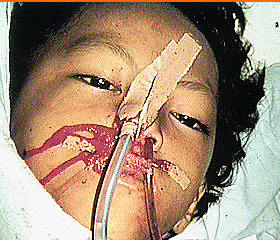
Microbial Diseases A to Z | Disease Home Page | Bio 406 Home Page | MicroWorld |

Viral hemorrhagic fevers (VHF) are among the scariest of viral diseases due to their dramatic symptoms, rapid time course, high mortality rate and lack of effective treatment. VHF have been dramatized in movies such as Outbreak and books such as The Hot Zone that describe the Ebola virus. However, numerous other hemorrhagic viruses exist, including Junin, Machupo, Guanarito, Sabia, Crimean-Congo, Lassa, Dengue, Yellow fever, Chapare, Marburg, Hanta, and Rift Valley. Many of these cause a disease syndrome accompanied by fever and multi-organ system failure which can lead to death.
VHF viruses fall into 4 major virus families: Arenaviruses, Bunyaviruses, Flaviviruses and Filoviruses.
| Virus | Family | Disease | Distribution | Transmission |
| Ebola | Filovirus | Ebola | Africa | DC |
| Marburg | Filovirus | Marburg HF | Africa | DC |
| Dengue fever virus | Flavivirus | Dengue HF | Africa | Vector |
| Yellow fever | Flavivirus | Yellow fever | Africa | Vector |
| Sin Nombre virus | Bunyavirus | Hantavirus Pulmonary syndrome | US | DC, inhalation |
| Hantaan virus | Bunyavirus | HFRS | Asia | DC, inhalation |
| Nairovirus | Bunyavirus | Crimean Congo HF | Africa | Vector |
| Phlebovirus | Bunyavirus | Rift Valley fever | Africa | Vector |
| Lassa virus | Arenavirus | Lassa HF | Africa | DC, inhalation |
| Junin virus | Arenavirus | Argentine HF | South America | DC, inhalation |
| Machupo virus | Arenavirus | Bolivian HF | South America | DC, inhalation |
| Guanarito virus | Arenavirus | Venezuelan HF | South America | DC, inhalation |
| Sabia virus | Arenavirus | Brazilian HF | South America | DC, inhalation |
| Chapare virus | Arenavirus | Chapare HF | South America | DC, inhalation |
Initial symptoms may be mild or severe, but usually include fever and malaise. Headaches, nausea, vomiting, liver damage and myalgia may follow. VHFs feature bleeding (both internal and external) that may be intestinal, respiratory, or from the eyes, often caused by damage to the vascular endothelium.
Differentiation of VHFs relies largely on patient history, e.g. contact with infected individuals (Ebola), animals (Hanta, Marburg), vectors (Crimean Congo, Dengue), and/or particular geographical locations. Specialized laboratory diagnosis may be necessary and include electron microscopy, antigen-based tests, genetic analysis or even viral culture. Because of the seriousness of VHF, such testing can usually only be done in BSL-4 labs.
Few treatments exist for VHFs other than supportive care. Rehydration and cardiovascular support can help counter blood loss, but ultimately viral damage to internal organs causes more damage than hemorrhaging alone. Ribavirin (Lassa) and some experimental drugs (Ebola) have been used with limited success. Prevention efforts are also limited to limiting contact with reservoir animals and vectors, as a vaccine exists for only one VHF (Yellow Fever).